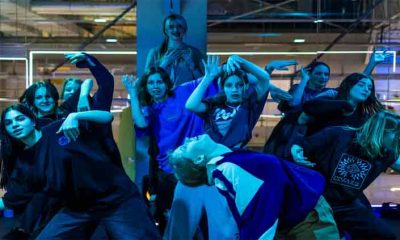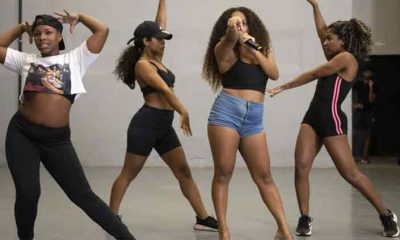Long before a bemused Riz Ahmed read its name on Oscar nominations morning, the title of Pamela Ribon’s short film has tended to have an effect on those who hear it. Like when Ribon went to pick up her festival credential at SXSW in Austin, Texas, shortly before premiering her movie there.
Guy at the desk: “What’s it called?”
Ribon: “My Year of Dicks.”
Guy at the desk, not missing a beat: “Hard same.”
There is, to be sure, no Oscar nominee this year quite like “My Year of Dicks” — and not just because of a title that, as Ribon notes, “is tough on a spam filter.”
The film, written and created by Ribon and directed by Sara Gunnarsdóttir, is one of the more hysterical, painful and sweet portraits of adolescence in all its awkwardness. It’s nominated for best animated short film at next month’s Academy Awards. Phil Lord (“Spider-Man: Into the Spiderverse,” “The Lego Movie”) has called the 26-minute movie “one of the best films of the year of any length.”
It’s based on Ribon’s 2014 memoir, “Notes to Boys (and Other Things I Shouldn’t Share in Public)” — particularly a chapter that documents 15-year-old Ribon’s resolution to lose her virginity in 1991 while growing up on the outskirts of Houston. It proceeds as five cringe-inducing chapters of intimate encounters with not-so-great guys, though — as damning as that title is — “My Year of Dicks” is less about judgment for Ribon’s far-from-ideal romantic partners than it is about recounting, and illuminating, the bumbling first steps of sex.
“It’s cheeky but it isn’t mean,” Ribon said in a recent interview by Zoom from her home in Los Angeles. “It really was an inclusive feeling of: ‘We all got through that somehow, didn’t we?’”
When they were starting out, Gunnarsdóttir, an Icelandic animator who crafted the vivid animations of “Diary of a Teenage Girl, ” wondered if “Notes to Boys” would be a better, less troublesome title. But Ribon sensed something relatable — nay, something universal — about “My Year of Dicks.”
“Not everybody has sent a note to a boy but everybody’s had a year of dicks — academically or in business or dating. It has a lot of layers,” Ribon says. “So it has been a way to bring everyone in, unfortunately. Everyone’s like ‘Hard same.’”
“My Year of Dicks,” which is streaming on Vimeo, has emerged, against the odds, as one of the most talked-about films at this year’s Oscars. Not only will much be riding on whether Ribon and Gunnarsdóttir can win on March 12, but perhaps even more eagerly awaited will be seeing which presenter, at the most dignified of awards shows, gets to utter the film’s name for an audience of millions, on live television.
“Do you think they’ll bleep it?” anxiously wonders Ribon.
For Ribon, 47, “My Year of Dicks” is an oddly appropriate culmination. Though her best known credits as a screenwriter are for more kid-friendly cartoons (“Moana,” “Ralph Breaks the Internet”), Ribon has, as an essayist, blogger and podcaster, long been an uncommonly open book. Her 2012 essay, “How I Might Have Just Become the Newest Urban Legend,” described a less than, um, sanitary trip to the masseuse parlor while she was many months pregnant.
“People were like: ‘It just would never occur to me to share that story with people,’” Ribon says. “And I was like, ‘What would you do?’ They were like, ‘Never tell anyone ever for the rest of life my life what just happened to me.’ I was like, ‘Oh!’”
“I do sometimes feel like a walking cautionary tale,” says Ribon.
Even as a teen, Ribon was deeply aware of the tragicomedy of her coming of age. She didn’t keep a diary but she prodigiously wrote, either by typewriter or by hand, about her life. Holding up a thick green notebook, Ribon flips through the short stories, notes to boys and ticket stubs she accrued through those years.
“I liked to have an audience from the beginning when I was processing my thoughts,” says Ribon. “I’m still that way. I much prefer writing an email about my day than keeping it to myself. It feels weird to talk to me.”
“My Year of Dicks” began as a television project for FX Networks, but the filmmakers ultimately decided to try their luck on the festival circuit. Since the Walt Disney Co. owns FX, “My Year of Dicks” technically counts, ironically enough, as one of Disney’s Oscar nods, alongside the likes of “Avatar: The Way of Water” and “Turning Red.”
As time went on, “My Year of Dicks” began to appear different, and more distant to Ribon. The overturning of Roe v. Wade made such sexual exploration far more perilous for young women. Texas law bans abortions after roughly six weeks of pregnancy and makes no exceptions for rape or incest. Ribon’s film, increasingly, looked like a time capsule of a bygone era.
“In modern day Texas, this is the most dangerous thing a girl can do with her future. These people should not be responsible for lifelong decisions because of a party,” says Ribon. “At least I felt free to find out. Now, I would have been too scared to learn about myself. I’m grateful for the mistakes I was able to make. I didn’t have sex in any of those situations but it could have happened. And it could have happened with just one person being more a dick than here. It’s so much scarier to think about.”
But Ribon believes animation offers “a tool to talk to someone’s unfiltered heart” — that even in an a very adult animated film, it’s possible to connect back to, as she says, “that part where we set out with the best intentions for ourselves.”
“We’re thrown back into Saturday morning cartoon feelings,” she says.
So, yes, “My Year of Dicks” might be the most giggle-inducing Oscar nominee this year. But it also may be the most nakedly heartfelt.
“Maybe that’s my job in life, to help people know that you’re not alone and it could be worse. There is something very satisfying about knowing I officially have the worst sex talk of all time. It’s not just something that I say,” Ribon says, pausing to smile. “The academy has spoken.”
Post Views: 66


 Fashion3 months ago
Fashion3 months ago
 Sports3 months ago
Sports3 months ago
 Sports3 months ago
Sports3 months ago
 Fashion2 months ago
Fashion2 months ago
 pakistan3 months ago
pakistan3 months ago
 World3 months ago
World3 months ago
 pakistan3 months ago
pakistan3 months ago
 Tech3 months ago
Tech3 months ago






















